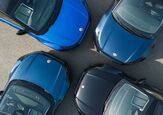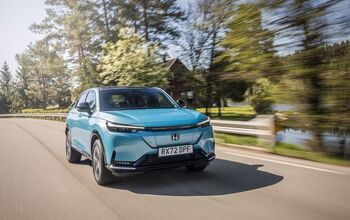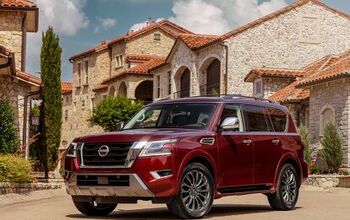QOTD: Your Least Favorite Rear-drive Nineties Ride?

Last week, we accepted suggestions for our readers’ least favorite front-drive cars from the 1990s, but commenter Art Vandelay (an importer/exporter) wanted more. We’re back a week later to repeat the same question, but with a focus on rear-drive rides. Let the aero-infused criticism begin.
Don’t worry, we’re not picking on that Purp Drank Impala SS. The rules this time around will be the same as the last edition of this game, mostly:
- Only vehicles with model years between 1990 and 1999 are eligible for submission.
- Vehicles from any manufacturer qualify.
- Qualifying vehicles were sold as new in North America.
Though there were still many rear-drive sedans in the Nineties, lots of other things were rear drive, too — keep that in mind. I’ll stick with a sedan criticism here, one which may surprise you.
Before you is the second-generation Infiniti Q45. Infiniti’s first flagship debuted for the 1990 model year, aimed directly at HMS Lexus LS400. Contrasting with the Lexus, the Q45’s rather avant garde grille-free design was paired with a minimalist interior. Free of ruched leather and wood trim (which its competitors had), the Q45 was also largely free of buyers.
Though the sedan impressed motoring journalists, Real People shied away from its beefy 4.5-liter V8. Consumers opted in droves for the more conservative, more luxurious, and more prestigious Lexus. While Lexus spent more than a decade developing a car to suit the American luxury market, Nissan chose to bring over a revised version of its President executive sedan, which debuted in the Japanese domestic market that same year. Marketing of the Q45 was also an issue, as Infiniti opted for modern and minimal advertisements that featured trees, but not the car for sale. Time to try again, Infiniti said.
In 1997, a new Q45 arrived in North America. This one was slightly smaller than the original, placing less emphasis on modernism and sports and more on conservative luxury, just like Lexus. Suddenly, there was lots of ruched leather and wood trim, and a fancy clock which looked upon a top-tier interior of Nissan Maxima parts. Based on the less expensive Japanese market Cima, the Q had a lesser engine as well. Though the “45” remained on the back, a more accurate representation would’ve said “41.” Under hood was a 4.1-liter V8 from the VH engine line. It produced 268 horsepower (a respectable number), but the unique sporty proposition was gone. This second Q45 was broadly labeled as a Japanese Buick and forgotten by most everybody. Infiniti tried for sports luxury again in 2002, but it was too late. Infiniti never went all-in with attempts to tackle Lexus for sedan dominance, and it showed. The second generation Q45 was a great example of what happens when an expensive car is developed half-heartedly.
What rear-drive Nineties ride doesn’t do it for you?
[Images: General Motors, Infiniti]

Interested in lots of cars and their various historical contexts. Started writing articles for TTAC in late 2016, when my first posts were QOTDs. From there I started a few new series like Rare Rides, Buy/Drive/Burn, Abandoned History, and most recently Rare Rides Icons. Operating from a home base in Cincinnati, Ohio, a relative auto journalist dead zone. Many of my articles are prompted by something I'll see on social media that sparks my interest and causes me to research. Finding articles and information from the early days of the internet and beyond that covers the little details lost to time: trim packages, color and wheel choices, interior fabrics. Beyond those, I'm fascinated by automotive industry experiments, both failures and successes. Lately I've taken an interest in AI, and generating "what if" type images for car models long dead. Reincarnating a modern Toyota Paseo, Lincoln Mark IX, or Isuzu Trooper through a text prompt is fun. Fun to post them on Twitter too, and watch people overreact. To that end, the social media I use most is Twitter, @CoreyLewis86. I also contribute pieces for Forbes Wheels and Forbes Home.
More by Corey Lewis
Latest Car Reviews
Read moreLatest Product Reviews
Read moreRecent Comments
- Ajla My understanding is that the 5 and 7-Series cater almost exclusively to the Chinese market and they sell them here just so they don't look weak against Mercedes and Audi.
- EBFlex Interesting. We are told there is insatiable demand for EVs yet here is another major manufacturer pivoting away from EV manufacturing and going to hybrid. Did these manufacturers finally realize that the government lied to them and that consumers really don’t want EVs?
- Kwik_Shift_Pro4X What's worse than a Malibu?
- MaintenanceCosts The current Malibu is poorly packaged; there's far more room inside a Camry or Accord, even though the exterior footprint is similar. It doesn't have any standout attributes to balance out the poor packaging. I won't miss it. But it is regrettable that none of our US-based carmakers will be selling an ordinary sedan in their home market.
- Jkross22 You can tell these companies are phoning these big sedans in. Tech isn't luxury. Hard to figure out isn't luxury.This looks terrible, there are a lot of screens, there's a lot to get used to and it's not that powerful. BMW gave up on this car along time ago. The nesting doll approach used to work when all of their cars were phenomenal. It doesn't work when there's nothing to aspire to with this brand, which is where they are today. Just had seen an A8 - prior generation before the current. What a sharp looking car. I didn't like how they drove, but they were beautifully designed. The current LS is a dog. The new A8 is ok, but the interior is a disaster, the Mercedes is peak gaudy and arguably Genesis gets closest to what these all should be, although it's no looker either.



































Comments
Join the conversation
In Australia... 1. The 1990-92 Ford Falcon (EA II/EB I). The 3.9's in these sucked, far worse than the 4.1 it replaced and the 4.0 that would replace it... 2. 1989-92 FSM Niki. It was a 1972-80 Fiat 126 built in Poland... 3. 1996-2006 Ssangyong Korando. I dislike the front end on these...just looks weird to me. Dishonourable mentions: 1. Any 1994-2000 MB (especially the 1G Sprinter). Why do 1G Sprinters rust so badly? 2. Volvo 940/960 (particularly the sedan). It didn't look as good as the 2s or 7s. not to mention, the belts on the I6 and also the PRV was still initially available. The door panels don't seem to age well...many I've seen aren't in great condition...
What years did Ford have that awful Mustang II?